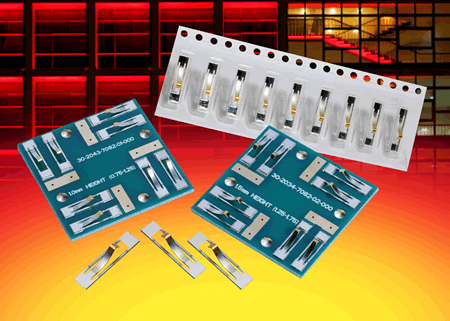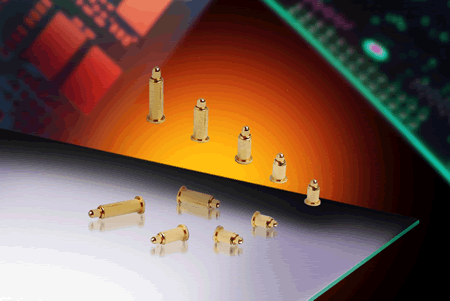How to Specify Medical Connectors
The development of modular medical devices, such as pluggable or wearable drug dispensing and patient monitoring equipment, poses several engineering challenges. AVX’s Tom Anderson offers tips on how to specify medical connectors.
The development of modular medical devices, such as pluggable or wearable drug dispensing and patient monitoring equipment, poses several engineering challenges. Although electronic components capable of performing the necessary analysis, measurement, and feedback tasks are widely available, few are small or robust enough to satisfy the unique demands of these devices.
In addition to satisfying the general demands for smaller, lighter, and more multifunctional electronics, which pose several design challenges of their own, external interface connectors designed into pluggable or wearable medical devices must also be electrically and mechanically robust enough to provide long lifetime performance despite frequent handling, mating, and unmating and intermittent exposure to a variety of harsh environmental hazards, such as liquids or chemicals.
The most important element to consider when specifying external interface connectors for these uniquely demanding medical applications is the base contact material. Phosphor bronze is one of the most commonly employed contact materials due to its low price point — another design consideration that cannot be ignored — and is more than sufficient for use in a wide range of applications, but it cannot provide the high-reliability, long life cycle performance required of modular medical devices. Beryllium copper is the ideal material for these types of applications. Although slightly more expensive than phosphor bronze, beryllium copper exhibits high contact force and maximum deflection cycles without fatiguing, making it an excellent choice for use in critical, harsh environment medical applications.
Since physical space is at a premium, cost is an undeniable concern, and the ultimate performance of a connector stems from its base contact materials, plating, and mechanical attributes, engineers should also consider single-contact solutions instead of standard connectors when designing modular medical equipment. In addition to eliminating the costs associated with the insulator and its assembly, individual contacts can be integrated directly into the outer housing of medical devices, which enables the best mechanical and environmental fit possible and helps to ensure long-term reliability.
One of the most reliable and forgiving contact systems that is suitable for use in high-life-cycle, harsh-environment medical applications is a ruggedized, single-piece compression contact. Unlike two-piece contact systems, which require extremely precise pre-alignment, single-piece compression contact systems feature a high spring-force contact that mates to a flat surface on the pluggable end, which allows the system to absorb broad Z-axis or mating tolerances, as well as large X-Y tolerances, with expanded or staggered contact pads.
Two specific compression contacts that provide ideal solutions for modular medical electronics applications (provided that they are matched to the application dimensionally and made with premium base materials to provide the required level of performance and robustness) are cantilever beam contacts and pogo pin contacts.
Cantilever beam contacts deflect during the mating process, sweeping across the pad to remove any debris or oxidation that might have accumulated since it was last mated or used. Made using beryllium copper and featuring a gold-on-gold interface, cantilever beam contact systems are designed to accept a sliding (i.e., perpendicular) or angular mating direction, which enhances design flexibility and can provide years of reliable connections in demanding medical applications. In fact, depending on the base material thickness and contact geometry, these contacts can provide a minimum of 5,000 mating cycles, making them particularly ideal for use in pluggable modules.

Figure 1: AVX 70-9155 Series ultra low-profile board-to-board cantilever beam compression contact
Spring-loaded pogo pin (i.e., plunger) contact systems also provide high reliability, long life cycle solutions for modular medical applications. Similar to cantilever beam contact systems, the critical component of pogo pin contacts is the spring mechanism. Unlike cantilever beam contacts, however, pogo pin contacts utilize stainless steel to provide the high spring force between the body and the gold-plated plunger, which compresses during mating, and can only accept a straight (i.e., vertical) mating direction. Consequently, pogo pin contacts are frequently employed in docking applications, in which a device is plugged into a base station. Despite their limitations with regard to the mating angles they are compatible with, pogo pin contacts provide a minimum of 10,000 mating cycles, even in harsh environment applications, making them another ideal solution for modular medical electronics designs.

Figure 2: AVX 70-9150 Series pogo pin board-to-board contacts
As is always the case, the material selection of the base contact is the most critical component to consider when specifying a connector, as it determines just how robustly and reliably the interconnect will perform. However, unique solutions like individual cantilever beam and pogo pin compression contacts — both of which are available in a variety of configurations, sizes, and thicknesses to match the final compressed height and provide the exact contact force required — can help engineers meet the litany of electrical, mechanical, and environmental design specifications required of modular medical devices.
[hr]
 Tom Anderson has been in the connector industry for more than 30 years and has held a variety of product marketing positions. For the last four years, he has been focused on developing new connector technologies for the industrial and solid-state lighting markets for AVX.
Tom Anderson has been in the connector industry for more than 30 years and has held a variety of product marketing positions. For the last four years, he has been focused on developing new connector technologies for the industrial and solid-state lighting markets for AVX.
- State of the Industry: 2022-2023 Connector Sales - April 16, 2024
- Amphenol is On a Roll - April 2, 2024
- Nicomatic Proves That Two Heads are Better Than One - March 26, 2024





